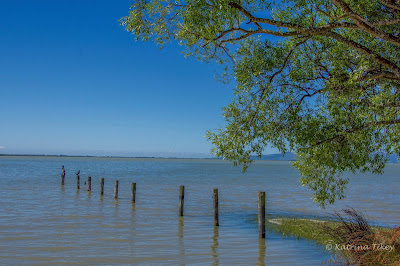The saying 'You learn something everyday' was perfect for me last weekend. I set off to explore Lake Ellesmere and headed for 'Lakeside Domain'. I'd been told it was a good place to stay. However I hadn't been told that it was one of New Zealand's most polluted lakes. Had I known that I doubt I would of let the dogs swim in it.
Lake Ellesmere, also known as Te Waihora (the spreading water) is located west of Banks Peninsula, and is about 40 minutes from Christchurch. It's not actually a lake, it's a shallow lagoon that is separated from the Pacific Ocean by a long, narrow spit called 'Kaitorete Spit' (or Kaitorete Barrier) which is about 28kms long.
Regular openings of the lagoon prevent flooding and maintain fish stocks by letting ocean-spawning fish (such as eels, mullet and flounder) enter and leave the lake.
Lake Ellesmere has no natural opening out to sea. Openings are usually aligned with fish migration periods, however other factors are taken into account, such as ...
* access for traditional mahinga kai, including gathering of swan's eggs.
* to avoid low lake levels in summer.
* the need to support wetland bird and plant habitats with various lake levels.
* when drain networks and infrastructure is effected by high lake levels.
Advice is given from experts regarding machinery and the forecast for weather and sea conditions are considered when deciding to open the lake. Usually it takes three days to open the lake if conditions are favourable.
Once the lake is opened, The length of time it stays open is determined by weather, sea conditions and how quickly gravel is deposited by the sea to close the channel.
Unbeknown to me (at the time of our visit) this lake experiences toxic algal blooms which are hazardous to people and animal's health. Dogs are especially vulnerable to it. When we arrived I noticed a sign near the entrance showing levels of toxic algae. It indicated the lagoon was at a safe level. I checked before letting them in, tit was free of algae - plus someone nearby had several dogs swimming.
Lake Ellesmere/Te Waihora is Canterbury's largest lake and is an important wildlife area.It covers 20,000 hectares (about the same size as Lake Wanaka). It's an unusual lagoon as it's salty and shallow (an average depth of 2 metres).
We stopped at Lakeside Domain to check the camping area. It's a popular place for boating and other water-based activities. There are showers, toilets and rubbish bins in the domain. The area is spacious, with trees around to provide shade and privacy. And it's free.
There have been 166 species of birds recorded at Te Waihora, with up to 98,000 birds on the lake at one time. At least 37 species breed in the lake and live there during the year.
The lake also has native fish, including whitebait and eel. Basking sharks and stingrays have also been spotted in the lake at times.
Lake Ellesmere is an area of cultural, natural, historic, recreational and commercial importance to many people. To Ngai Tahu, the lagoon represents a gathering place for food and natural materials.
 |
| Plenty of bird life about, but I had the dogs so didn't approach them for photos. |
 |
| Lots of areas to choose to camp - some spots have rows of trees to provide privacy and shade. |











Fantastic. Thanks for the info. I'll be sure to visit in the new year when we are next down in the south island.
ReplyDeleteHave a great time - I'm sure you'll enjoy it.
ReplyDelete